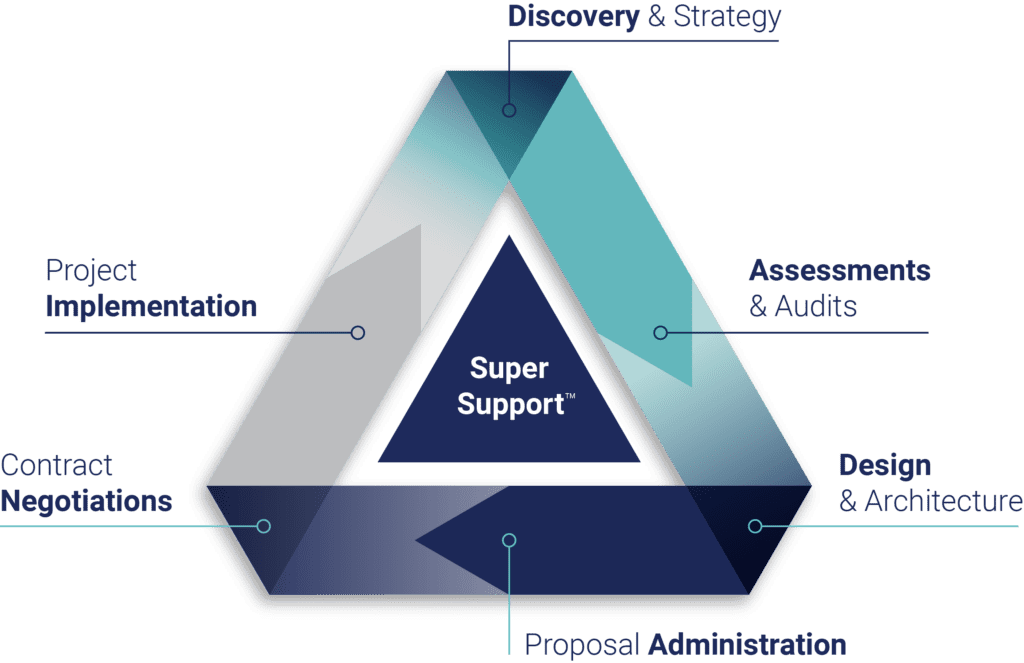
ATC’s Delta Model Provides Successful Path to Positive Business Outcomes
Years back, during the evolution of ATC’s consulting practice, it became apparent the scope of work being performed within the firm was much more holistic and strategic than in the past. As a result, newly onboarded clients became larger and more complex, which suited ATC’s expertise even better.
Today, ATC finds itself immersed daily in digital transformations in four core areas: voice, network, cloud and cybersecurity. In fact, ATC has niched itself as the go-to advisor and solution identifier for complex IT decisions and digital transformations. ATC has come a long way from its transactional broker days of yesteryear. Thus, the logo and branding were due for a change.
Accordingly, ATC has rolled out a refreshed logo, branding, and website to reflect ATC’s position more accurately in the DX marketplace. Phase one of ATC’s new website is up and running, with phase two slated for release in May.
ATC’s new logo and brand colors are refreshed but not altogether brand new. Keeping aspects of the original brand was key to ATC. What remains as part of the new brand identity is the triangle, the blue (albeit a different shade of blue) and gray colors, and “ATC” in all caps. What is new is the aqua color and the 3D-like, technology-forward favicon.

DX and ATC’s Delta Model
Over the years, larger organizations have gravitated to ATC’s innovative business model and process, which is now monikered with this rebrand as ATC’s “Delta Model,” which includes the Delta process (see below). ATC’s Delta Model is a unique and proven methodology for digital transformation. It is solution agnostic, provider neutral, and grounded in expertise and process with access to a technology marketplace of 400+ providers. It also includes ongoing Super Support™.

“Digital transformations are critical for ongoing business success,” says ATC co-founder and managing partner, Darren DeMartino. “Done right, they can create strategic differentiation and market leaders. On the other hand, missteps can lead to loss of market share and a marginalized bottom line. Businesses that take no action will surely get left behind.”
Many transformation projects do, in fact, get stuck in the pilot stage. Mostly because leaders are wary of replacing legacy systems. This is mainly due to existing investments, knowledge gaps, competing priorities, and a lack of resources. For companies in this predicament, ATC’s Delta Model has become indispensable for organizations looking to leverage IP-based, digital solutions to build scalable infrastructures.
“We help organizations navigate the incredibly complex, evolving technology ecosystem, which becomes even more interconnected by the day,” states ATC co-founder & managing partner, David Goodwin. “We accelerate digital transformations with deep, segment-specific expertise and gain praise from our clients for our Super Support.”
ATC has two offices. DeMartino leads the Hartford, CT, office, and Goodwin the Cincinnati, OH, office.
“It’s an exciting time for us,” adds Louie Hollmeyer, ATC director of marketing and consultant. “Our work with clients has been wrapped around DX for some time now, and it was essential for us to create a refreshed brand identity to better align with today and tomorrow. We also felt we needed to create a marque—ATC’s Delta Model—for our unique, client-centered value proposition.”
How it All Evolved
In 1999, Darren DeMartino and David Goodwin launched ATC as a broker of telecom services. Their business model was rooted in the concept of “independent consulting” and the ability to offer a portfolio of products and services, and not be confined to a specific carrier or product set. At the time, they had the foresight to recognize that—one way or another—there would ultimately be a convergence of telecom and IT. Hence, the name Advanced Technology Consulting rather than Advanced Telecom Consulting.
This convergence began with hosted VoIP, where voice became just another application to run across the network. Of course, this put even more emphasis on connectivity and “the network” at a time when businesses were already connectivity-dependent and hogging bandwidth. Today, ATC has 75,000+ UCaaS/CCaaS seats under management and has become a national leader in wide-area network (WAN) architecture and design.
Cloud technologies in the form of SaaS applications, colocation, IaaS, and public and private cloud were the next—and third—frontier for ATC’s burgeoning consulting practice. The natural fourth frontier is, of course, cybersecurity. Everything must be wrapped with multi-layered security to protect organizations from cyber-attacks and the theft of digital assets.
ATC’s change in direction many years ago—led by Goodwin and DeMartino—from a “broker” of traditional telecom services to a strategic, next-gen technology consultant put the company squarely at the forefront of digital transformations and where it is today!







